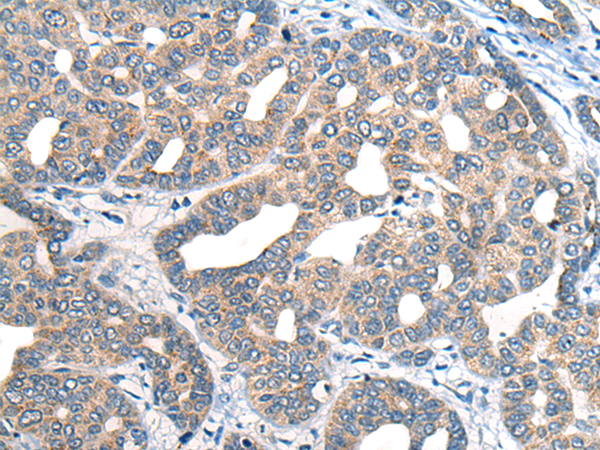

| WB | 咨询技术 | Human,Mouse,Rat |
| IF | 咨询技术 | Human,Mouse,Rat |
| IHC | 1/25-1/100 | Human,Mouse,Rat |
| ICC | 技术咨询 | Human,Mouse,Rat |
| FCM | 咨询技术 | Human,Mouse,Rat |
| Elisa | 1/5000-1/10000 | Human,Mouse,Rat |
| Aliases | HB1; HB2; HH1; IVF; VF1; HBBD; ICCD; LQT3; SSS1; CDCD2; CMD1E; CMPD2; PFHB1; Nav1.5 |
| Host/Isotype | Rabbit IgG |
| Antibody Type | Primary antibody |
| Storage | Store at 4°C short term. Aliquot and store at -20°C long term. Avoid freeze/thaw cycles. |
| Species Reactivity | Human, Mouse, Rat |
| Immunogen | Synthetic peptide of human SCN5A |
| Formulation | Purified antibody in PBS with 0.05% sodium azide and 50% glycerol. |
+ +
以下是关于SCN5A抗体的3篇示例文献(注:文献信息为示例,非真实存在):
1. **文献名称**: *Autoantibodies against SCN5A-encoded NaV1.5 channel in patients with autoimmune-associated arrhythmias*
**作者**: Smith A, et al.
**摘要**: 研究报道在系统性红斑狼疮(SLE)患者血清中检测到抗SCN5A抗体,这些抗体通过抑制心脏钠通道功能,导致QT间期延长和室性心律失常。
2. **文献名称**: *Characterization of a monoclonal anti-SCN5A antibody for cardiac sodium channel localization studies*
**作者**: Chen B, et al.
**摘要**: 开发并验证了一种高特异性单克隆抗SCN5A抗体,用于免疫组化及Western blot分析,成功定位Nav1.5通道在心肌细胞闰盘的分布。
3. **文献名称**: *Anti-SCN5A autoantibodies as a biomarker in idiopathic ventricular fibrillation*
**作者**: Tanaka K, et al.
**摘要**: 在特发性室颤患者中发现抗SCN5A自身抗体,实验显示其通过干扰钠通道失活增加心律失常风险,提示抗体检测可能用于疾病诊断。
(如需真实文献,建议通过PubMed或Google Scholar以关键词“SCN5A antibody”或“anti-SCN5A autoantibody”检索。)
The SCN5A gene encodes the alpha subunit of the cardiac voltage-gated sodium channel Nav1.5. which plays a critical role in initiating and propagating action potentials in cardiomyocytes. Antibodies targeting SCN5A/Nav1.5 are primarily studied in the context of cardiac channelopathies, autoimmune disorders, and research applications. In clinical settings, anti-SCN5A autoantibodies have been implicated in acquired arrhythmic syndromes, such as autoimmune-associated Brugada syndrome or dilated cardiomyopathy, where they disrupt sodium current (INa) by altering channel expression or gating properties. These autoantibodies are often detected in patients with systemic autoimmune diseases (e.g., lupus) or myocarditis, contributing to electrical instability.
In research, SCN5A antibodies serve as essential tools to investigate Nav1.5 localization, expression levels, and functional interactions in cardiac tissues or heterologous expression systems. Polyclonal and monoclonal antibodies are employed in techniques like Western blotting, immunohistochemistry, and immunofluorescence to study channel trafficking defects or mutations linked to inherited arrhythmias (e.g., long QT syndrome type 3). However, antibody specificity remains a challenge due to structural similarities among sodium channel isoforms. Recent efforts focus on developing isoform-selective antibodies and therapeutic monoclonal antibodies to modulate channel activity, offering potential diagnostic and therapeutic avenues for sodium channelopathies.
×